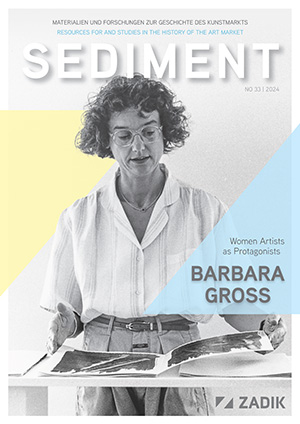Archiv

sediment
Nr. 33 (2024)
Barbara Gross setzte sich als Herausgeberin von Kunst-Editionen seit 1981 und als Galeristin in eigenen Räumen in München seit 1988 fast über 40 Jahre für mehr Sichtbarkeit von Frauen im Kunstmarkt ein. Das sediment 33 beleuchtet die Zeitspanne von den Anfängen der vielfältigen Vermittlungstätigkeit von Barbara Gross bis Ende der 1990er Jahre. Anhand der meist über Jahrzehnte währenden Zusammenarbeit mit Künstlern und Künstlerinnen sowie ausgewählter Projekte wird die Programmatik der Galerie dargestellt. Ergänzend dazu beleuchten zwei Zeitzeuginnen ihre Tätigkeit aus dem Blickwinkel Museum und Berichterstattung. Persönliche Perspektiven vermitteln abschließend die Statements von Künstler:innen, Kurator:innen, Sammler:innen und Kolleg:innen, die Barbara Gross verbunden sind.

sediment
Nr. 32 (2023)
30 Years of ZADIK
Im sediment 32 nimmt das ZADIK anlässlich des 30. Jubiläums die eigene Historie sowie Bestände, die Kontexte zur Kunst und die Vielfalt im Kunstmarkt in den Fokus: Die Meilensteine führen durch drei Jahrzehnte der Geschichte des ZADIK. Vertiefte Einblicke geben Interviews mit den ehemaligen Direktoren und Vorsitzenden des damaligen ZADIK e.V. sowie die Statements von mit dem ZADIK verbundenen Personen. Über die Dokumentation der Jubiläumsausstellung und des Artistic Research-Projekts des Kollektiv ZOO werden (Kunst-)Geschichten rund um Exponate aus den Archivbeständen des ZADIK sichtbar. Der Gastbeitrag gibt aktuelle und zukünftige Perspektiven auf die Kunstmarktforschung und reflektiert die eigene Disziplin kritisch.

sediment
Nr. 31 (2020)
5 Jahre Avantgarde: Helmut Rywelskis art intermedia, Köln 1967-1972
Der Kölner Galerist Helmut Rywelski sorgte zwischen 1967 und 1972 mit seiner Galerie art intermedia und der Kritik am kommerziellen Kunstbetrieb für Furore. In Erinnerung bleiben u.a. spektakuläre Aktionen wie der von Wolf Vostell einbetonierte Opel Kapitän "Ruhender Verkehr" (1969) oder von Jörg Immendorff "Für alle Liebenden der Welt" (1967). Rywelski vertrat Kunst „in und zwischen allen Medien“ in einer Zeit der dynamischen Medialisierung des öffentlichen Lebens. Insbesondere sozial engagierte, kritische und politische Kunst wie beispielsweise von H. P. Alvermann, Joseph Beuys und Lil Picard war sein Thema, und solange er selbst Teil des neuen Kunstmarkts war, bekämpfte er diesen zugleich, bis er nach fünf Jahren in der Erkenntnis der unaufhaltsamen Ökonomisierung des Kunstbetriebes die Galerie aufgab und wieder als Journalist arbeitete.

sediment
Nr. 30 (2019)
Klaus Honnef. Von der Konzeptkunst zur Fotografie / From Conceptual Art to Photography
Klaus Honnefs Lebensleistung, dokumentiert in seinem 2012 dem ZADIK übergebenen Archiv und zusammengefasst in diesem Heft, ist geprägt von Premieren und Superlativen. Für das 1968 von ihm mitbegründete und geleitete Zentrum für aktuelle Kunst – Gegenverkehr in Aachen ersann er ein multimediales Konzept und gab dort Gerhard Richter (1969) und Lawrence Weiner (1970) ihre ersten Einzelausstellungen jenseits der kommerziellen Galerienszene. Mit Umwelt Akzente – Die Expansion der Kunst, Monschau 1970, schuf er den Prototyp für Ausstellungen im (städtischen) Außenraum. Als Geschäftsführer des Westfälischen Kunstvereins in Münster (1970-1974) verhalf er Douglas Huebler (1972), Sigmar Polke, Jörg Immendorff (1973) und Christian Boltanski (1974) zu ihren erste Einzelsausstellungspremieren in einer öffentlichen Ausstellungsinstitution und Hanne Darboven (1971) mit 4.500 qm zur flächenmäßig größten Schau ihrer Karriere verhalf. Zur documenta 5 (1972) bestellte ihn Harald Szeemann gemeinsam mit Konrad Fischer zu Kuratoren für die Konzeptkunst in der Sektion Idee + Idee/Licht. Seit 1973 ist Gabriele Honnef-Harling an seiner Seite und arbeitet mit ihm zusammen. Gemeinsam schufen sie auch das multimediale Konzept für die umstrittene documenta 6 (1977), für die Honnef zusammen mit Evelyn Weiss und Honnef-Harling die beiden Abteilungen „Malerei“ und „Fotografie“ betreute und die Fotografie erstmals als eigenständiges künstlerisches Ausdrucksmittel vorstellte, eine Erkenntnis, die er bei der Arbeit an der ersten Retrospektive von Bernd und Hilla Becher gewonnen hatte, 1975 am Rheinischen Landesmuseum Bonn. Honnef prägte die Begriffe Autorenfotografie, Analytische Malerei und Inszenierte Fotografie, und viele künstlerische Erscheinungsformen, die erst später – manche erst in jüngster Zeit – ihre kanonischen Bezeichnungen erhielten, erfuhren bei ihm ihre erste Würdigung. Er hat zahlreiche Bücher geschrieben, darunter das erste Buch über Concept Art (1971), sowie Kunst der Gegenwart (1988) und Andy Warhol (1989), zwei Weltbestseller, die in mehr als zehn Sprachen übersetzt wurden, und unzählige Artikel in Fachzeitschriften, Tages- und Wochenzeitungen. Unter seinen Ehrungen ragen heraus seine Honorarprofessur an der Kunsthochschule Kassel, seine Ernennung zum Chevalier de l´ordre des arts et des lettres durch die Republik Frankreich und der Kulturpreis der Deutschen Gesellschaft für Photographie.


